
|
It brightened very rapidly. Another outburst occured around Sept. 22, and it became strongly condensed. Now it is very bright visually as 9.2 mag (Oct. 6, Piotr Guzik). It approaches to the earth down to 0.4 A.U., and it is observable in good condition in September and October.
Date(TT) R.A. (2000) Decl. Delta r Elong. m1 Best Time(A, h)
Oct. 6 0 3.92 23 4.9 0.436 1.416 159 9.1 23:01 (180, 31)
Oct. 13 23 53.94 27 42.4 0.458 1.420 152 9.3 22:23 (180, 27)
|

|
Now it is so bright as 9.3 mag (Oct. 5, Juan Jose Gonzalez). Getting lower graudally in the evening sky. It will be unobservable in late September in the Southern Hemisphere, or in mid October in the Northern Hemisphere. In the Southern Hemisphere, it will appear in the morning sky at 9 mag in 2013 February, then it keeps observable in good condition while fading slowly. In the Northern Hemisphere, it is hardly observable after 2013.
Date(TT) R.A. (2000) Decl. Delta r Elong. m1 Best Time(A, h)
Oct. 6 15 22.18 3 31.8 2.844 2.168 39 10.0 19:33 (100, 8)
Oct. 13 15 32.87 0 37.7 2.851 2.123 35 9.9 19:40 ( 94, 5)
|

|
It is expected to be a great comet of -1 mag in 2013 spring. Now it is 11.0 mag (Oct. 1, Con Stoitsis). Brightening faster than originally expected. In 2012, it keeps observable until October in the Southern Hemisphere. In the Northern Hemisphere, it keeps unobservable for a long time until 2013 March, when the comet will appear as a 0-mag great comet.
Date(TT) R.A. (2000) Decl. Delta r Elong. m1 Best Time(A, h)
Oct. 6 15 14.78 -27 25.7 3.579 2.906 41 11.4 19:33 ( 72, 23)
Oct. 13 15 19.92 -28 1.1 3.555 2.811 36 11.2 19:40 ( 68, 18)
|

|
Now it is so bright as 11.2 mag (Oct. 4, Chris Wyatt). It is expected to be observable at 11-13 mag for a long time from 2012 summer to 2013 summer. It is not observable until 2013 January in the Northern Hemisphere. In the Southern Hemisphere, it will be extremely low from October to December.
Date(TT) R.A. (2000) Decl. Delta r Elong. m1 Best Time(A, h)
Oct. 6 14 5.39 -53 32.6 2.566 2.086 50 11.7 19:33 ( 40, 24)
Oct. 13 14 21.04 -51 11.4 2.653 2.081 45 11.8 19:40 ( 41, 20)
|
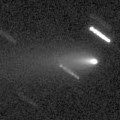
|
Now it is bright and visible visually at 12.6 mag (Sept. 16, Artyom Novichonok). It is expected to approach to the earth and to be observable at 8 mag in good condition in winter. The condition is good in the Northern Hemisphere. In the Southern Hemisphere, it will be unobservable after this. But it will become observable in good condition after 2013 January.
Date(TT) R.A. (2000) Decl. Delta r Elong. m1 Best Time(A, h)
Oct. 6 14 38.74 41 13.7 1.781 1.421 52 12.7 19:33 (126,-22)
Oct. 13 14 35.67 40 51.2 1.720 1.360 52 12.4 19:40 (122,-28)
|

|
It kept as bright as 6-7 mag for a long time from 2011 summer to 2012 spring. Now it is appearing in the morning sky.
Date(TT) R.A. (2000) Decl. Delta r Elong. m1 Best Time(A, h)
Oct. 6 10 4.55 1 37.7 4.531 3.837 41 12.6 4:03 (260, 11)
Oct. 13 10 6.18 0 31.7 4.510 3.904 47 12.7 3:52 (259, 15)
|

|
First return of a new periodic comet which brightened up to 14 mag in 2005. It brightened very rapidly and became much brighter than originally expected. Now it is very bright as 11.4 mag (Sept. 13, Juan Jose Gonzalez). It keeps observable in excellent condition at 11-13 mag from summer to autumn.
Date(TT) R.A. (2000) Decl. Delta r Elong. m1 Best Time(A, h)
Oct. 6 1 58.58 35 12.8 0.584 1.518 145 12.9 1:00 (180, 20)
Oct. 13 1 53.48 37 53.8 0.591 1.533 148 13.0 0:28 (180, 17)
|
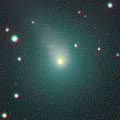
|
It brightened much faster than expected. Now it is so bright as 11.5 mag (Sept. 15, Seiichi Yoshida). In the Northern Hemisphere, it keeps observable at 11-13 mag in good condition until early 2013. In the Southern Hemisphere, it is not observable until late 2012.
Date(TT) R.A. (2000) Decl. Delta r Elong. m1 Best Time(A, h)
Oct. 6 10 8.35 34 38.7 2.744 2.315 54 13.3 4:03 (234,-10)
Oct. 13 10 8.90 33 6.1 2.682 2.347 59 13.3 3:52 (233, -6)
|

|
Now it is so bright as 11.2 mag (Sept. 14, Carlos Labordena). It will be unobservable soon. But it will be observable at 12-13 mag in good condition again in 2013.
Date(TT) R.A. (2000) Decl. Delta r Elong. m1 Best Time(A, h)
Oct. 6 15 17.70 -14 1.3 6.048 5.296 37 13.3 19:33 ( 84, 17)
Oct. 13 15 18.66 -14 17.7 6.135 5.309 31 13.3 19:40 ( 79, 10)
|
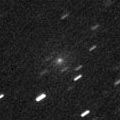
|
Now it is 15.4 mag (Aug. 11, Hidetaka Sato). However, it is extremely diffuse. The nuclear magnitude is fainter than 19 mag. Maybe the comet has been disintegrated, and will disappear soon. It keeps observable for a long time until December, but it keeps locating low in the evening after this.
Date(TT) R.A. (2000) Decl. Delta r Elong. m1 Best Time(A, h)
Oct. 6 15 58.25 -8 53.4 1.750 1.301 47 13.4 19:33 ( 95, 23)
Oct. 13 16 24.33 -12 5.7 1.772 1.315 47 13.4 19:40 ( 91, 23)
|
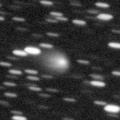
|
Now it is 13.3 mag (Sept. 13, Jakub Cerny). It keeps bright at 13-14 mag for a long time until 2014. It keeps observable for a long time in the Northern Hemisphere. It is not observable in the Southern Hemisphere.
Date(TT) R.A. (2000) Decl. Delta r Elong. m1 Best Time(A, h)
Oct. 6 20 55.57 48 45.8 5.630 6.113 114 13.5 19:53 (180, 6)
Oct. 13 20 50.17 47 8.8 5.655 6.100 112 13.5 19:40 (177, 8)
|

|
It brightened rapidly, and reached up to 10 mag from July to August. Now it is fading. But it is bright as 11.5 mag still now (Sept. 15, Seiichi Yoshida). It keeps observable in the morning sky after this.
Date(TT) R.A. (2000) Decl. Delta r Elong. m1 Best Time(A, h)
Oct. 6 9 20.34 4 55.0 1.513 1.207 52 13.7 4:03 (251, 18)
Oct. 13 9 37.09 2 43.9 1.543 1.268 54 14.4 3:52 (252, 19)
|

|
Now it is bright as 13.1 mag (Sept. 22, Jakub Cerny). It keeps bright as 13-14 mag for a long time after this until 2013. It is not observable in the Northern Hemisphere, but it is observable in good condition in the Southern Hemisphere.
Date(TT) R.A. (2000) Decl. Delta r Elong. m1 Best Time(A, h)
Oct. 6 4 41.98 -57 9.6 5.536 5.826 101 13.8 3:43 ( 0, 68)
Oct. 13 4 34.99 -57 28.7 5.537 5.844 103 13.8 3:08 ( 0, 68)
|
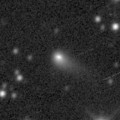
|
Now it is bright and visible visually at 12.8 mag (Oct. 5, Juan Jose Gonzalez). It keeps observable in good condition at 13-14 mag for a long time until winter. It locates somewhat low in the Southern Hemisphere.
Date(TT) R.A. (2000) Decl. Delta r Elong. m1 Best Time(A, h)
Oct. 6 23 41.30 36 34.3 2.345 3.216 145 14.0 22:39 (180, 18)
Oct. 13 23 40.11 35 16.0 2.333 3.204 145 13.9 22:10 (180, 20)
|

|
Now it is so bright as 12.4 mag (Aug. 17, Carlos Labordena). It will be too low to observe in the evening sky soon. But it will be observable at 12-14 mag in good condition again in 2013. However, it locates somewhat low in the Northern Hemisphere in 2013.
Date(TT) R.A. (2000) Decl. Delta r Elong. m1 Best Time(A, h)
Oct. 6 14 41.43 -9 18.0 3.785 2.945 28 14.1 19:33 ( 83, 7)
Oct. 13 14 51.76 -10 28.0 3.817 2.937 24 14.1 19:40 ( 79, 3)
|

|
Big asteroid discovered in 1906. It suddenly showed the cometary activity on Dec. 11, 2010, probably due to an impact of a small object. Now it is 11.9 mag (May 29, Marco Goiato). It has already turned to be stellar.
Date(TT) R.A. (2000) Decl. Delta r Elong. m1 Best Time(A, h)
Oct. 6 17 22.36 -30 45.8 2.699 2.521 69 14.1 19:33 ( 82, 50)
Oct. 13 17 34.42 -31 2.2 2.786 2.529 64 14.2 19:40 ( 79, 45)
|

|
Not observable now. It will appear in the morning sky in late November.
Date(TT) R.A. (2000) Decl. Delta r Elong. m1 Best Time(A, h)
Oct. 6 13 3.99 -15 1.1 7.226 6.246 10 14.3 19:33 ( 64, -9)
Oct. 13 13 9.04 -15 32.5 7.233 6.246 7 14.3 3:52 (299,-12)
|
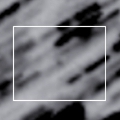
|
First return of a new periodic comet discovered in 1994. Now it is 16.0 mag (Sept. 19, J. Linder). It is expected to brighten rapidly, to reach up to 13.5 mag, and to be observable in good condition from autumn to winter. However, most observers reported it around 18 mag, much fainter than this ephemeris.
Date(TT) R.A. (2000) Decl. Delta r Elong. m1 Best Time(A, h)
Oct. 6 19 35.01 20 40.3 0.931 1.510 102 15.0 19:33 (164, 33)
Oct. 13 19 46.64 18 8.0 0.908 1.464 100 14.8 19:40 (156, 34)
|

|
Now it is 14.9 mag (Sept. 14, Jakub Cerny). In the Southern Hemisphere, it will be observable at 15-16 mag in good condition for a long time until 2013 summer. It is not observable at all in the Northern Hemisphere.
Date(TT) R.A. (2000) Decl. Delta r Elong. m1 Best Time(A, h)
Oct. 6 16 54.74 -80 40.3 3.952 3.913 80 15.4 19:33 ( 10, 40)
Oct. 13 17 12.81 -80 40.7 4.011 3.921 77 15.4 19:40 ( 10, 39)
|

|
It kept as bright as 11-12 mag for a long time from 2011 autumn to 2012 spring. Now it is 16.1 mag (Sept. 14, A. Diepvens). It keeps observable in good condition until next spring while the comet will be fading gradually.
Date(TT) R.A. (2000) Decl. Delta r Elong. m1 Best Time(A, h)
Oct. 6 9 41.75 8 21.9 3.418 2.852 48 15.4 4:03 (251, 11)
Oct. 13 9 50.34 7 30.3 3.375 2.885 52 15.5 3:52 (251, 13)
|
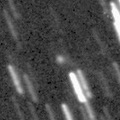
|
Now it is 16.1 mag (Sept. 15, A. Diepvens). It is expected to brighten up to 10 mag from winter to spring in 2013. In the Northern Hemisphere, it keeps observable in good condition until 2013 April. It is not observable now in the Southern Hemisphere. It will become observable after 2013 April, but it keeps locating low.
Date(TT) R.A. (2000) Decl. Delta r Elong. m1 Best Time(A, h)
Oct. 6 16 46.22 87 14.5 2.907 3.135 93 15.8 19:33 (177,-33)
Oct. 13 17 10.62 86 21.3 2.798 3.066 95 15.6 19:40 (176,-33)
|

|
Now it is 15.7 mag (Sept. 8, P. Dupouy, J. B. de Vanssay)�$B!#�(BIt keeps 15-16 mag from autumn to winter. It keeps observable in good condition for a long time until the comet fades out in the Northern Hemisphere. It is not observable until 2013 summer in the Southern Hemisphere. By the way, Juan Jose Gonzalez reported it extremely bright as 10.7 mag visually on Sept. 6.
Date(TT) R.A. (2000) Decl. Delta r Elong. m1 Best Time(A, h)
Oct. 6 10 5.46 70 19.9 3.579 3.548 80 15.8 4:03 (202,-28)
Oct. 13 10 10.03 72 25.5 3.481 3.544 85 15.8 3:52 (199,-28)
|
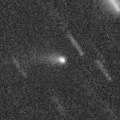
|
Now it is 15.9 mag (Sept. 13, Toshiyuki Takahashi). It will brighten up to 15 mag from autum to winter. In the Northern Hemisphere, it keeps observable for a long time until the comet fades out. It is not observable in the Southern Hemisphere, except for 2013 spring, but the comet locates extremely low only.
Date(TT) R.A. (2000) Decl. Delta r Elong. m1 Best Time(A, h)
Oct. 6 13 35.06 67 31.2 2.534 2.440 73 15.9 19:33 (152,-38)
Oct. 13 13 37.73 67 31.0 2.461 2.411 75 15.8 19:40 (152,-41)
|

|
It is expected to keep 13 mag and observable in good condition in the Northern Hemisphere for a long time from 2013 to 2014. Although it had been unobservable for a while, it is appearing in the morning sky now. It keeps unobservable until late November in the Southern Hemisphere.
Date(TT) R.A. (2000) Decl. Delta r Elong. m1 Best Time(A, h)
Oct. 6 11 9.87 16 4.3 6.059 5.240 32 16.1 4:03 (258,-11)
Oct. 13 11 13.45 16 20.8 5.943 5.196 38 16.0 3:52 (256, -8)
|
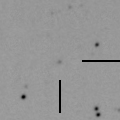
|
Jean-Francois Soulier reported that it had faded down to 19.8 mag on Sept. 16, however, it suddenly brightened up to 16.6 mag on Sept. 20. It brightened by about 3 mag in outburst. Now it is 15.9 mag, getting brighter furthermore (Sept. 22, Jakub Cerny). It keeps observable in excellent condition after this in the Northern Hemisphere. It locates somewhat low in the Southern Hemisphere.
Date(TT) R.A. (2000) Decl. Delta r Elong. m1 Best Time(A, h)
Oct. 6 2 35.78 28 24.8 2.126 3.003 145 16.3 1:37 (180, 27)
Oct. 13 2 29.41 28 11.9 2.120 3.042 152 16.6 1:03 (180, 27)
|
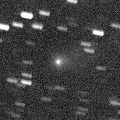
|
Now it is 16.0 mag (Sept. 14, Jakub Cerny). It tends to brighten after the perihelion passage. It keeps observable at 16-17 mag from 2012 to 2013. It will be too low to observe in mid November.
Date(TT) R.A. (2000) Decl. Delta r Elong. m1 Best Time(A, h)
Oct. 6 17 3.98 -23 6.2 3.457 3.153 64 16.6 19:33 ( 90, 43)
Oct. 13 17 13.35 -23 30.1 3.547 3.159 59 16.6 19:40 ( 86, 38)
|

|
Jakub Cerny reported the comet brightened up to 14.5 mag in late July. Now it is 15.2 mag, a bit brighter than this ephemeris still now (Sept. 14, Jakub Cerny). It will be observable in good condition in the Southern Hemisphere while fading gradually after this. It will locate somewhat low in the Northern Hemisphere.
Date(TT) R.A. (2000) Decl. Delta r Elong. m1 Best Time(A, h)
Oct. 6 22 46.57 -29 55.1 3.141 3.908 134 16.9 21:44 (180, 85)
Oct. 13 22 45.29 -29 54.8 3.267 3.962 128 17.0 21:16 (180, 85)
|

|
This comet brightened up to 10 mag in outburst in 1995, however, it became lost after that. The condition of this apparition is bad. It was not observable around the perihelion passage. But it is appearing in the morning sky now. However, it is not detected, fainter than 19.0 mag (Sept. 16, Martin Masek).
Date(TT) R.A. (2000) Decl. Delta r Elong. m1 Best Time(A, h)
Oct. 6 7 56.00 8 34.1 2.445 2.372 73 17.0 4:03 (232, 30)
Oct. 13 8 2.67 7 56.8 2.408 2.425 79 17.3 3:52 (230, 32)
|

|
Looks almost asteroidal. But it has a very faint tail. It passed near by the earth, and brightened up to 13.9 mag (July 22, Artyom Novichonok). Now it is fading, but still bright as 15.9 mag (Sept. 15, A. Diepvens). It keeps observable in excellent condition in the Northern Hemisphere. It locates extremely low in the Southern Hemisphere.
Date(TT) R.A. (2000) Decl. Delta r Elong. m1 Best Time(A, h)
Oct. 6 17 53.60 37 13.6 1.859 1.991 82 17.1 19:33 (149, 9)
Oct. 13 17 56.10 36 42.6 1.988 2.056 79 17.3 19:40 (143, 5)
|
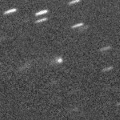
|
Now it is 17.5 mag (Sept. 13, S. Shurpakov). It keeps 17 mag for a long time from 2009 to 2013.
Date(TT) R.A. (2000) Decl. Delta r Elong. m1 Best Time(A, h)
Oct. 6 22 32.92 10 10.9 7.689 8.538 146 17.2 21:30 (180, 45)
Oct. 13 22 28.81 9 37.7 7.771 8.552 139 17.3 20:59 (180, 45)
|
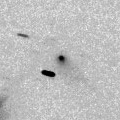
|
First return of a new periodic comet discovered in 2005. Now it is 16.6 mag (Sept. 4, Mitsunori Tsumura). It will be observable in excellent condition at 17-18 mag until November.
Date(TT) R.A. (2000) Decl. Delta r Elong. m1 Best Time(A, h)
Oct. 6 23 3.41 4 33.5 1.245 2.188 154 17.3 22:01 (180, 50)
Oct. 13 23 1.57 4 17.1 1.284 2.189 147 17.4 21:32 (180, 51)
|

|
The condition of this apparition is bad, and it was not observable around the perihelion passage. Now it is 17.1 mag (Sept. 14, A. Diepvens). It will be fainter than 18 mag in late October.
Date(TT) R.A. (2000) Decl. Delta r Elong. m1 Best Time(A, h)
Oct. 6 1 43.82 0 56.6 1.899 2.877 165 17.3 0:45 (180, 54)
Oct. 13 1 36.94 0 32.7 1.924 2.913 170 17.4 0:11 (180, 54)
|
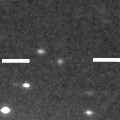
|
It is expected to be a great comet in 2013 autumn when the comet approaches to the sun down to only 0.01 A.U. It keeps visible with naked eyes from November to January, and can be extremely bright as Venus or more at the highlight. Now it is 17.4 mag (Sept. 23, D. T. Durig). The condition is excellent in the Northern Hemisphere. It keeps observable almost all through the period of brightening, at the highlight, and of fading. The condition is not good in the Southern Hemisphere. It is not observable at all the latter part of the highlight, and it keeps low all through the period. The orbit is similar to that of Comet Kirch in 1680.
Date(TT) R.A. (2000) Decl. Delta r Elong. m1 Best Time(A, h)
Oct. 6 8 17.75 27 48.4 6.368 6.147 72 17.4 4:03 (223, 12)
Oct. 13 8 19.48 27 50.5 6.184 6.079 79 17.3 3:52 (220, 14)
|

|
First return of a new periodic comet discovered in 1997 at 17 mag. It is expected to keep 17 mag for a long time from 2012 to 2014. The ephemeris says it is already 18 mag, but it has not been recovered yet. Toru Yusa reported that the comet was not detected, fainter than 19.5 mag, on July 18.
Date(TT) R.A. (2000) Decl. Delta r Elong. m1 Best Time(A, h)
Oct. 6 2 17.59 14 43.8 3.045 3.978 155 17.4 1:19 (180, 40)
Oct. 13 2 14.50 14 24.7 2.994 3.961 163 17.3 0:48 (180, 41)
|
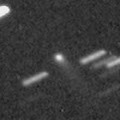
|
Although it was extremely faint as 20.0 mag on May 27 (Hidetaka Sato), it brightened rapidly. Now it is 16.6 mag (Sept. 15, F. G. Pinilla). It keeps observable in good condition at 17 mag from summer to autumn.
Date(TT) R.A. (2000) Decl. Delta r Elong. m1 Best Time(A, h)
Oct. 6 23 3.95 8 37.9 1.126 2.072 154 17.4 22:01 (180, 46)
Oct. 13 23 0.35 9 14.7 1.167 2.076 147 17.5 21:30 (180, 46)
|
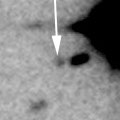
|
Now it is 17.2 mag (Sept. 11, K. Hills). In the Southern Hemisphere, it keeps observable at 17 mag in good condition for a long time from 2012 to 2013. It is not observable at all in the Northern Hemisphere.
Date(TT) R.A. (2000) Decl. Delta r Elong. m1 Best Time(A, h)
Oct. 6 7 11.52 -59 43.7 4.958 4.930 82 17.4 4:03 (330, 58)
Oct. 13 7 9.57 -61 57.8 4.930 4.920 83 17.4 3:52 (336, 58)
|
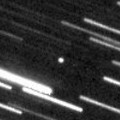
|
In the Northern Hemisphere, it will be observable at 17.5 mag in excellent condition in October and November. It locates low in the Southern Hemisphere.
Date(TT) R.A. (2000) Decl. Delta r Elong. m1 Best Time(A, h)
Oct. 6 3 25.23 45 19.0 1.384 2.142 127 17.7 2:27 (180, 10)
Oct. 13 3 6.76 45 8.8 1.351 2.177 135 17.6 1:41 (180, 10)
|

|
It brightened up to 12 mag in 2010. Now the comet is around the aphelion. But it will be observable at 17.5 mag in good condition from autumn to winter.
Date(TT) R.A. (2000) Decl. Delta r Elong. m1 Best Time(A, h)
Oct. 6 4 43.90 20 54.0 3.984 4.576 120 17.7 3:45 (180, 34)
Oct. 13 4 42.28 20 56.7 3.903 4.585 127 17.7 3:16 (180, 34)
|

|
It brightened up to 10 mag from autumn to winter in 2011. It has already faded down to 18.3 mag (Sept. 22, Jakub Cerny). In the Southern Hemisphere, it keeps observable in good condition while fading graudlaly after this. It will be hardly observable in the Northern Hemisphere.
Date(TT) R.A. (2000) Decl. Delta r Elong. m1 Best Time(A, h)
Oct. 6 4 55.98 -41 13.9 4.338 4.727 106 17.8 3:57 ( 0, 84)
Oct. 13 4 50.82 -43 3.9 4.363 4.786 109 17.9 3:24 ( 0, 82)
|

|
Now it is 17.4 mag (Sept. 29, A. Diepvens). It keeps 17-18 mag for a long time until the end of 2013. The condition is good in the Northern Hemisphere. It is hardly observable in 2012 in the Northern Hemisphere. But it will be observable in good condition in 2013.
Date(TT) R.A. (2000) Decl. Delta r Elong. m1 Best Time(A, h)
Oct. 6 0 38.15 59 3.0 4.149 4.806 126 17.9 23:35 (180, -4)
Oct. 13 0 24.17 57 34.8 4.087 4.782 129 17.9 22:53 (180, -3)
|
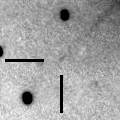
|
It was observed at 17 mag in 2011 autumn. It was expected to be observable at 17 mag in good condition again from autumn to winter in 2012. But actually, the comet was not detected, fainter than 21.0 mag (Sept. 21, Hidetaka Sato). The comet must have faded out very rapidly.
Date(TT) R.A. (2000) Decl. Delta r Elong. m1 Best Time(A, h)
Oct. 6 6 39.17 24 36.7 2.772 3.013 94 20.8 4:03 (205, 26)
Oct. 13 6 43.45 25 38.4 2.691 3.030 100 20.8 3:52 (201, 26)
|
|
![]()
 P/2012 NJ ( La Sagra )
P/2012 NJ ( La Sagra ) C/2008 S3 ( Boattini )
C/2008 S3 ( Boattini ) 261P/2012 K4 ( Larson )
261P/2012 K4 ( Larson ) 71P/Clark
71P/Clark C/2012 S1 ( ISON )
C/2012 S1 ( ISON ) P/1997 C1 ( Gehrels )
P/1997 C1 ( Gehrels ) 160P/LINEAR
160P/LINEAR C/2012 C1 ( McNaught )
C/2012 C1 ( McNaught ) (3200) Phaethon
(3200) Phaethon 65P/Gunn
65P/Gunn C/2010 G2 ( Hill )
C/2010 G2 ( Hill ) C/2012 S4 ( PanSTARRS )
C/2012 S4 ( PanSTARRS ) P/2011 N1 ( ASH )
P/2011 N1 ( ASH )![]()





































